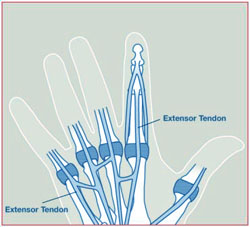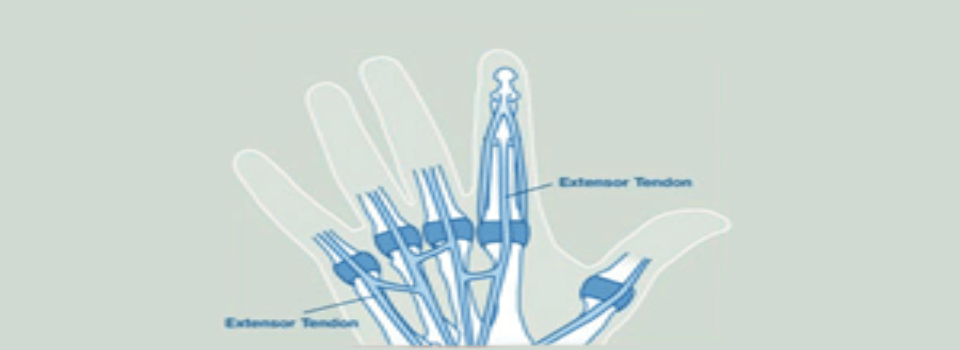 There are various types of extensor tendon injuries, but they all result in the patient being unable to straighten one more finger joints.
There are various types of extensor tendon injuries, but they all result in the patient being unable to straighten one more finger joints.
What is it?
The tendons that enable you to straighten your fingers, called extensor tendons, are on the back of the hand and fingers. Attached to the forearm muscles, they become flat and thin as they reach the fingers. Small finger muscles meet these tendons in the fingers and are what allow you to make small finger motions. Their delicate nature and location means that these tendons are quite easily injured.
What causes it?
 Seemingly minor injuries, such as a small cut or jamming a finger, can cause extensor tendon injuries.
Seemingly minor injuries, such as a small cut or jamming a finger, can cause extensor tendon injuries.
What are the symptoms?
There are various types of extensor tendon injuries, but they all result in the patient being unable to straighten one more finger joints. One common type of injury is mallet finger, which causes the end of the finger to droop down so that the patient cannot straighten it without manual intervention. Boutonniere deformity occurs when the middle joint of the finger is bent down due to a cut or tear of the extensor tendon on that joint. Cuts located on the back of the hand may go through the extensor tendons, making it difficult to straighten the finger at the bottom joint that joins the finger to the hand.
How do we diagnose it?
We usually need only to conduct a physical exam or x-ray to determine the presence of an extensor tendon injury.
 How is it treated?
How is it treated?
If a cut has split the tendon, as in mallet finger, the patient may require stitches. However, injuries related to finger jams are often treated with splints alone. A splint prevents the tendons from pulling apart and must be worn constantly until tendon heals completely, which can take one to two months. We will place the splint in the proper position and give specific directions on the manner and duration that it should be worn. If the splint is not utilized correctly, the finger can become even further bent and stiffen in that position. In addition to a traditional splint, an internal splint is sometimes used by placing a pin through the bone.
Even under the best circumstances when treatment directions are followed, the scar tissue that forms may result in a less than full recovery of finger mobility. In the case that a patient does not make a full recovery, we recommend hand therapy or, sometimes, surgery that frees the scar tissue. As with many types of hand injuries, we will study your individual case to determine the best course of action.


